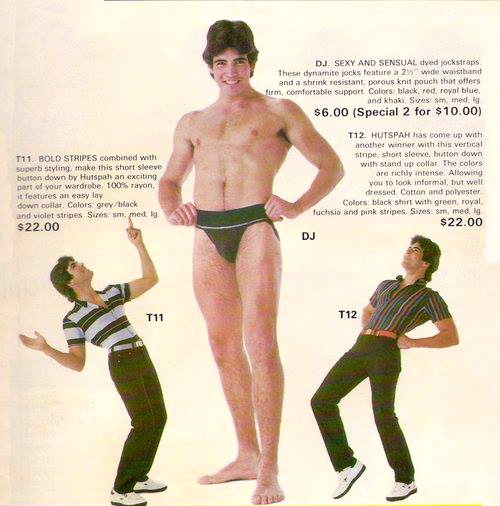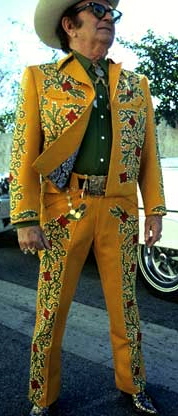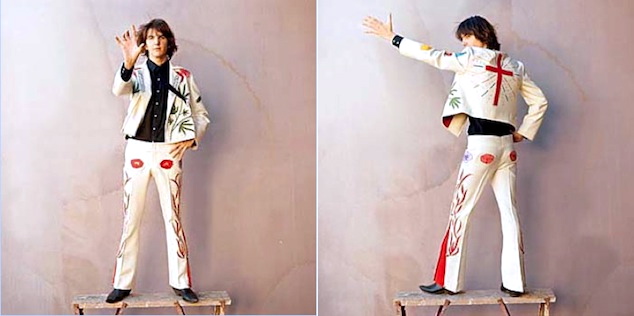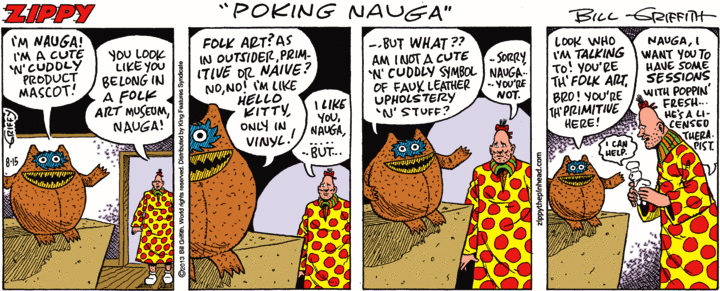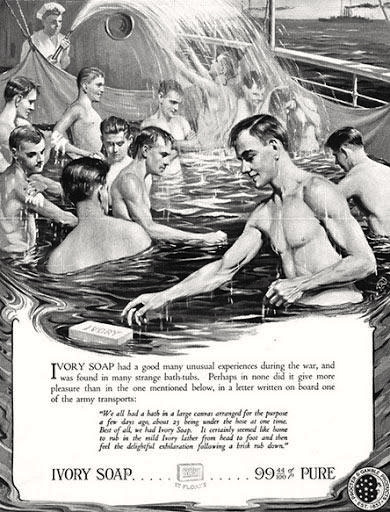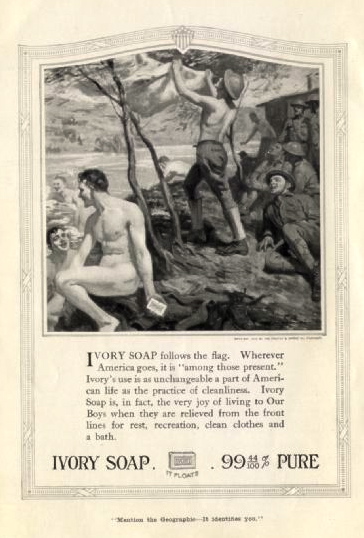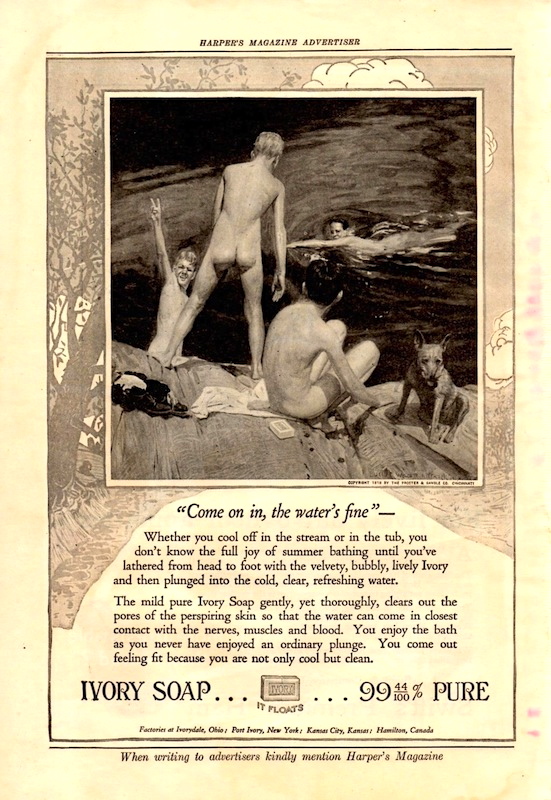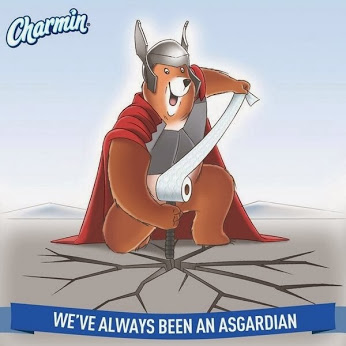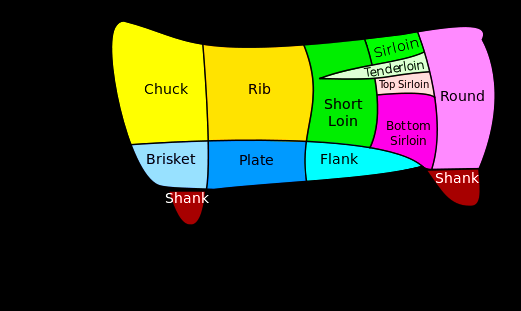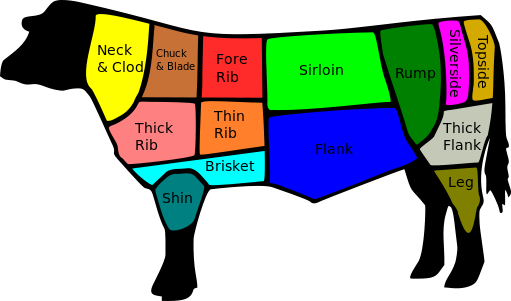From Facebook friends who passed this image (from Kitsch Bitsch) on:
Clearly a page from a catalogue, offering jockstraps (from an unnamed company) and Hutspah shirts, with the models arranged so that a giant smiling Jockstrap Man dominates the page and the two shirt models (well, the same model in two different shirts) appear to be marveling at the apparition.
The page is directed towards men (“an exciting part of your wardrobe”, “allowing you to look informal, but well dressed”), almost surely gay man (what straight guy would view jockstraps as “sexy and sensual”?). The hair styles suggest the ’70s, and it looks like the heyday of Hutspah shirts was the ’70s, when the company produced many extravagant items, like this Hawaiian shirt:
There are listings in business directories for a Hutspah Shirts at 185 W. Wyoming Ave. in Philadelphia, but with precious little information about the company.
Searching for Hutspah shirts led me to other remarkable shirts, especially the work of Nudie Cohn, a prince of excess. From Wikipedia:
Nudie Cohn (December 15, 1902 – May 9, 1984) was a Ukraine-born American tailor who designed decorative rhinestone-covered suits, known popularly as “Nudie Suits”, and other elaborate outfits for some of the most famous celebrities of his era. He also became famous for his outrageous customized automobiles.
Cohn was born Nuta Kotlyarenko in Kiev. To escape the pogroms of Czarist Russia his parents sent him at age 11, with his brother, Julius, to America. For a time he criss-crossed the country working as a shoeshine boy and later a boxer, and hung out, he later claimed, with the gangster Pretty Boy Floyd. While living in a boardinghouse in Minnesota he met Helen “Bobbie” Kruger, and married her in 1934. In the midst of the Great Depression the newlyweds moved to New York City and opened their first store, “Nudie’s for the Ladies”, specializing in custom-made undergarments for showgirls.
Relocating to California in the early 1940s, Nudie and Bobbie began designing and manufacturing clothing in their garage. In 1947 Cohn persuaded a young, struggling country singer named Tex Williams to buy him a sewing machine with the proceeds of an auctioned horse. In exchange, Cohn made clothing for Williams.[1] As their creations gained a following, the Cohns opened “Nudie’s of Hollywood” on the corner of Victory and Vineland in North Hollywood, dealing exclusively in western wear, a style very much in fashion at the time. Nudie’s designs brought the already-flamboyant style to a new level of ostentation with the liberal use of rhinestones and themed images in chain stitch embroidery. One of his early designs, in 1962, for singer Porter Wagoner, was a peach-colored suit featuring rhinestones, a covered wagon on the back, and wagon wheels on the legs. He offered the suit to Wagoner for free, confident that the popular performer (like Tex Williams) would serve as a billboard for his clothing line. His confidence once again proved justified and the business grew rapidly. In 1963 the Cohns relocated to a larger North Hollywood facility, renamed “Nudie’s Rodeo Tailors”, on Lankershim Boulevard.
Many of Cohn’s designs became signature looks for their owners. Among his most famous creations was Elvis Presley’s $10,000 gold lamé suit, worn by the singer on the cover of his 50,000,000 Elvis Fans Can’t Be Wrong album. He designed the iconic costume worn by Robert Redford in the 1979 film Electric Horseman, which is now owned and exhibited by the National Cowboy & Western Heritage Museum in Oklahoma City. He created Hank Williams’ white cowboy suit with musical notations on the sleeves, and Gram Parsons’ infamous suit for the cover of the Flying Burrito Brothers’ 1969 album The Gilded Palace of Sin, featuring pills, poppies, marijuana leaves, naked women, and a huge cross. Many of the film costumes worn by Roy Rogers and Dale Evans were Nudie designs. John Lennon was a customer, as were John Wayne, Gene Autry, George Jones, Cher, Ronald Reagan, Elton John, Robert Mitchum, Pat Buttram, Tony Curtis, Michael Landon, Glenn Campbell, Hank Snow, and numerous musical groups, notably America and Chicago. The members of ZZ Top sported “Nudie Suits” on the cover photo of their 1975 album Fandango! In 2006 Porter Wagoner said he had accumulated 52 Nudie Suits, costing between $11,000 and $18,000 each, since receiving his first free outfit in 1962. The European entertainer Bobbejaan Schoepen was a client and personal friend; his collection of 35 complete stage outfits is the largest in Europe.
The man in one of his own creations:
Elvis in the famous suit:
And Gram Parsons in his:
There are so many to choose from.

